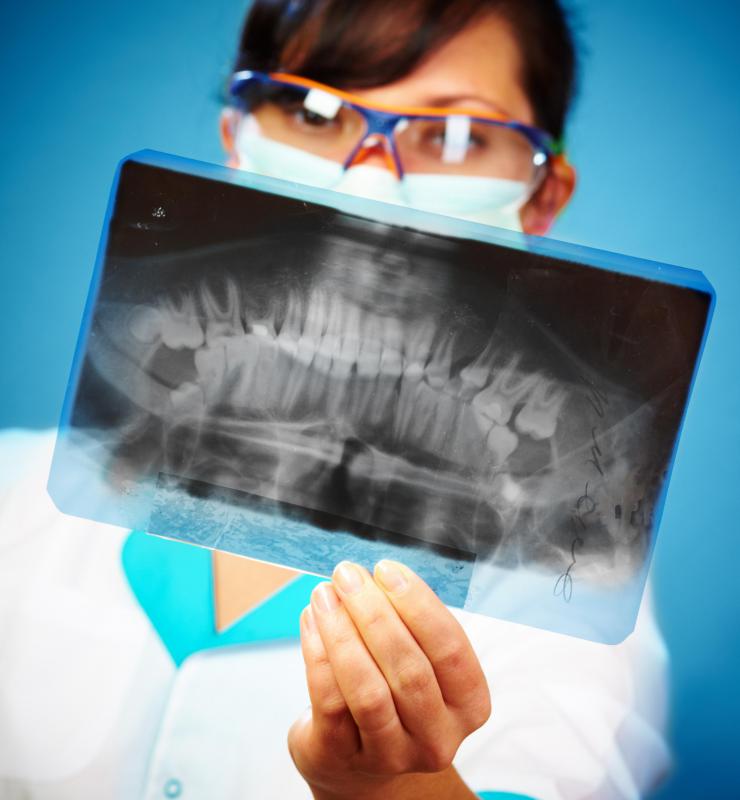At WiseGEEK, we're committed to delivering accurate, trustworthy information. Our expert-authored content is rigorously fact-checked and sourced from credible authorities. Discover how we uphold the highest standards in providing you with reliable knowledge.
What Are Self-Ligating Braces?
Orthodontic braces are devices that are used to correct a wide variety of tooth and jaw alignment problems. Traditional braces have metal bands that are placed over each tooth or brackets that are glued to the fronts, then connected by a wire that is tied to each tooth. The wires are typically held in place by a combination of wires and stiff elastic bands. Self-ligating braces are similar to traditional braces, but instead of each tooth being tied separately to the connecting wire, called the arch wire, each band has a small catch, something like a trap door, that holds onto the arch wire. The term self-ligating means that these braces tie themselves, in this case to the main wire.
The main advantages of self-ligating braces are that they are quicker for the orthodontist to fit to the patient’s teeth and typically require fewer office visits in order to maintain them, due to the method of the arch wire attachment; the trap on each tooth can quickly be closed over the wire instead. This is a fast alternative to the time-consuming tying of each tooth to the connecting wire and results in much less time spent during the initial fitting and subsequent adjustments to the self-ligating braces. One nickname for this type of braces is speed braces, because they can be installed and adjusted so quickly.

Many people feel that self-ligating braces are more comfortable to wear than other styles of braces, since the arch wire is able to move slightly along the front of the teeth. This often results in less stress on the teeth, which means less pain to the wearer; however, the orthodontist has less control over each individual tooth. Each is not tightly tied to the arch wire, making specific adjustments more difficult to control.

Other benefits of self-ligating braces is that they tend to be much easier to keep clean, resulting in less problems with tooth decay as a result of food particles getting trapped by the braces. The bases of these braces are often made of metal, but may also be made at least partially of translucent ceramic, making the braces far less noticeable than all-metal fittings or bands. In most cases, these braces require fewer office visits and may have a significantly shorter treatment time, cutting off as much as six months compared to other orthodontic systems.

Proponents of self-ligating braces claim that this technology requires less intervention prior to the start of individual tooth adjustments. Pulling teeth is less common, and the use of headgear and palate expanders is much more infrequent than with more traditional types of braces. This is due to the method used for adjustments, allowing the orthodontist to tailor the treatment to the patient’s overall needs.
AS FEATURED ON:
AS FEATURED ON:















Discussion Comments
I wear one of the most popular brands and I'm happy with them. It's actually kind of cool because the braces are "intelligent." My dentist programmed them so they know exactly how much force to apply. The best part is that self-ligating braces look much better than traditional ones. This was actually one of my bigger concerns when my doctor recommended braces. But they don't look bad, I'm happy.
@SteamLouis-- Yes, self-ligating braces are just as effective as traditional braces. In fact, because self-ligating braces fit better, they cause less issues and require less moderation, they are easier to use than self-ligating braces. This may mean that someone who has trouble with regular braces can wear self-ligating braces comfortably and for the entire treatment period. So I think that self-ligating braces are superior.
There are also several different types of self-ligating braces out there. They all work the same way, but there are different brands that make use of slightly different types of materials.
It's great that self-ligating braces are more comfortable and easier to maintain, but are they as effective as traditional braces. Since there is less stress on each tooth, will the teeth be aligned properly with self-ligating braces?
Post your comments